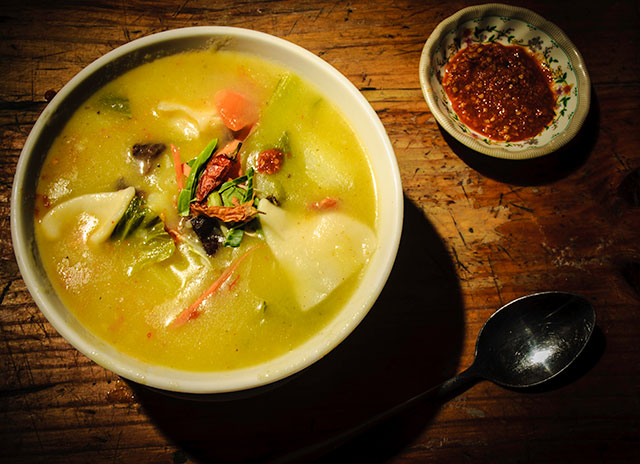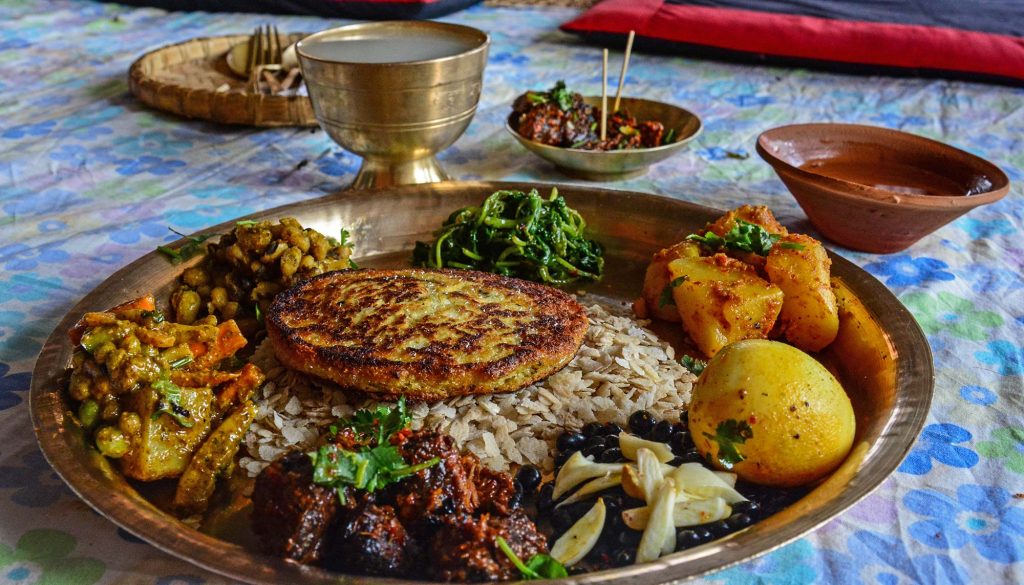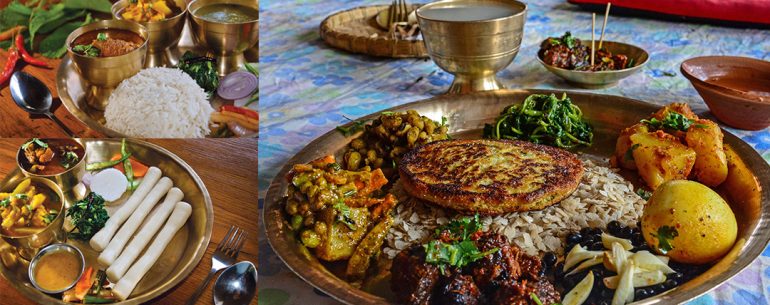Dalbhat and momos have become synonymous with Nepali food but Nepali cuisine is much more than that. There are a plethora of eateries to choose from all across Nepal whether it be in your trekking routes or big cities with common items like bhat (rice), dal (lentils), momos (dumplings), samosas (potato pastry) to name a few. However there has been a movement in Nepal, especially in Kathmandu, to popularize indigenous crops and foods so the public is not dependant on imported grains like rice but in homegrown ones like kodo (millet), phapar (buckwheat), and jau (barley). Another way you can help the local economy while enjoying your stay here is by enjoying local and indigenous cuisine wherever you go. In this blog, we list five such cuisines complete with some delicious dishes you can enjoy whether you are sightseeing in Chitwan or scaling mountains in the Himalayas.
Tharu:

Tharu people are indigenous to the south of Nepal, the Terai region. They utilize a variety of food sources around them including a type of sticky rice called anadi rice. Since they historically settled on much of the lush plains, forests, and nearby streams, such of their cuisine also reflects this. If you find yourself in a Tharu community, definitely try out their plethora of river and lake crustaceans (crab and snails, in particular). They also eat field mice, pigeons, wild boar, pig, and chicken for protein. Other food items that are commonly eaten in the Tharu community is the Khariya, spiced lentils wrapped in taro leaves which are then sliced and fried and the dhikri, rice cakes which are dipped in spcies. Another popular item is teel ko laddu or tilauri, sesame seed balls rolled in molasses. And these are just a few out of the many dishes you can try. So the next time you find ourself near a Tharu community, definitely try something new aside from our beloved (but well tested) dalbhat.
Sherpa:

We now move away from the southern plains of Nepal and go to the utmost northern region, the Himalayas. As Tharus are indigenous to the Terai, Sherpas are to the Himalayas. The most common food items found in the mountains are potatoes, barley, radish, wheat, and of course, yak meat. If you are planning to trek the Everest region for instance, definitely check out rikikur, a pancake made by grating potatoes and topped with rich yak butter or achar. If you need to warm up though, your best bet would be the thenduk, which is a flattened noodle soup served with yak meat and topped with spices, carrots, radishes, spring onions, and potatoes and is served piping hot. A favorite amongst both city dwellers and tourists alike is the shyabhale which is a fried pastry filled with minced meat and spices. These dishes are sure to keep you warm whether you are already in the mountains or are planning a winter getaway to Kathmandu. Either way, you won’t go wrong with Sherpa cuisine.
Rai/Limbu:

https://kathmandupost.com/food/2019/04/19/welcome-to-eastern-nepal-now-lets-eat
We now head towards the Eastern hills of Nepal where we come across Rai and Limbu communities. Some staple food items from these indigenous groups are millet, pork, stinging nettle, and even wild lichen! The dish yangben is made from boiling wild lichen found on trees. A rich and filling dish, it tastes as interesting as it sounds. The lichen is generally eaten either with pork or sargemba, a traditional pork blood sausage. The selroti, a popular dish that is widely eaten across Nepal, is rice flour batter mixed with ghee (clarified butter) and fried as a ring. While rice needs no introduction, vegetables and meat dishes are also eaten with dhido. Dhido is buckwheat flour cooked in hot water and pounded to make a paste. It is quite filling and serves as one of the staple dishes that is synonymous with the community. So the next time you find yourself in a restaurant, consider swapping out the rice for dhido instead for a new gastronomical experience.
Khas:
While food from Terai, the east, and even the Himalayas have spread across Nepal and dishes like tilauri (Tharu), thenduk (Sherpa), and selroti (Rai/Limbu) are well known, cuisine from the far Western region of the country remains relatively unknown. One particular dish that stands out is the Dukpa, which is dumpling soup where the dumplings are made from gahat (horse gram) and kalo mas ko dal (black lentils). Highly nutritious, this soup can be eaten with rice or roti. Speaking of rotis, most of the ones you find in restaurants are made from maida (all purpose flour) but the Khas people also make rotis with corn flour which serves as a healthy alternative. While there are not many eateries serving far Western food in the capital city, definitely keep an eye out for local food items when you’re trekking near Rara lake where you can also enjoy the marsi rice, a special type of locally grown rice which has a signature brown and red color.
Newari:

https://www.insidehimalayas.com/must-try-newari-food-nepal/
Last but definitely not the least is the Newari cuisine and you don’t have to travel very far from the capital to try this cuisine. In fact, you don’t have to travel at all since the Newari people are indigenous to Kathmandu. While Newari food is popular amongst those who live in Kathmandu, those who visit may not be familiar. Newari food is known for its spiciness and for the variety of meat dishes it offers. Whether it is hakuchoela, buffalo meat broiled and mixed with spices, or bhuttan, fried buffalo intestines, there is always something for meat lovers. Vegetarian dishes are also popular with bara (spiced and fried lentil patty) being a staple lunch item for many. Another simple but delicious dish would be bhatmas which is simply salted and roasted soybeans or the aalutama, which a potato and bamboo shoots curry cooked with black eyed peas. Accompanying these dishes would be chiura, which is rice that has been flattened. Again, a welcome substitute for the boiled rice we have been enjoying for so long. There is no dearth of Newari eateries in Kathmandu, especially in the three Durbar Squares (Kathmandu, Bhaktapur, and Patan) so definitely accompany your sightseeing with some mouthwatering Newari dishes.
Of course, this is not an exhaustive list of all the cuisines in Nepal but it is definitely a start! The next time you think you’ll order a plate of momos, keep this list in mind and try something new. Maybe you’ll find your next favourite dish or cuisine altogether!
Source:
https://kathmandupost.com/opinion/2018/09/02/making-the-most-of-marsi
https://kathmandupost.com/food/2019/04/19/welcome-to-eastern-nepal-now-lets-eat
https://www.insidehimalayas.com/must-try-newari-food-nepal/


Leave a Reply